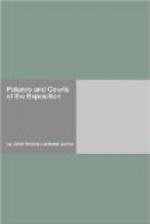-
Architect — Henry Bacon of New York.
Architecture — Italian Renaissance.
There is a strong feeling of the architectural influence of Hadrian’s Villa, near Rome, when the eye rests on the half dome and also on the treatment of the columns in front of the fountains of the seasons.
This is one of the chief beauty spots of the Exposition. A quiet, reposeful, happy place where birds have built their nests and where they sing their carols of spring.
As you pass into this court from the bay, or north side, your attention is drawn almost immediately to the bucrania, or bulls’ heads, between festoons of flowers.
This is only a Renaissance motive, but the mind wanders back to the harvest festivals of olden days, when, after the great harvest procession was over, the bulls were sacrificed to the gods as a reward for the abundant harvest. The same idea is worked out in “The Feast of the Sacrifice,” the magnificent bull groups atop the pylons (by Albert Jaegers), where youths and maidens lead the bulls in the harvest procession. Great garlands suggest the festivity.
The whole court is an expression of the abundance of the harvests — especially those of California.
-
Ceres, the goddess of agriculture, with her wreath of cereals and her corn sceptre, has just poised on the top of the lovely fountain (by Mrs. Evelyn Longman), the die of which tells you by its cameo figures that this is the fountain of young, fresh, joyous nature. The graceful, happy creatures with garlands and fruits glide past you in song, shaking the tambourine or softly piping their roundelays.
Jolly satyrs, the happy creatures of the woodland, spout water into the basin below.
-
The Food Products Palace is on one side, the Agricultural Palace on the other, and the suggestions worked out in the corn of the Ionic capital, the cereal wreaths on the frieze, the sheaves of wheat, are most happy decorations for just this court.
-
Pass to the Pool beyond and stop to read the quotation. (from Spenser’s “Faerie Queene”) on the western gateway.
“So forth issew’d the seasons of the yeare
First lusty spring all dight in leaves and flowres
Then came the jolly sommer being dight in a thin silken
cassock coloured
greene
Then came the autumne all in yellow clad
Lastly came winter, clothed all in frize
Chattering his teeth, for cold that did him chill.”
-
Facing the half dome, walk first to the second niche to the right of the colonnade to examine Furio Piccirilli’s Seasons.
Spring — A pyramidal group with Spring with her flowers in the center of the group. To the right is modest, timid, fresh young Flora, bringing her wealth of flowers.
To the left, one sees man adoring, bringing to mind Tennyson’s lines from Locksley Hall.
“In the spring a young man’s fancies
Lightly turn to thoughts of love.”




